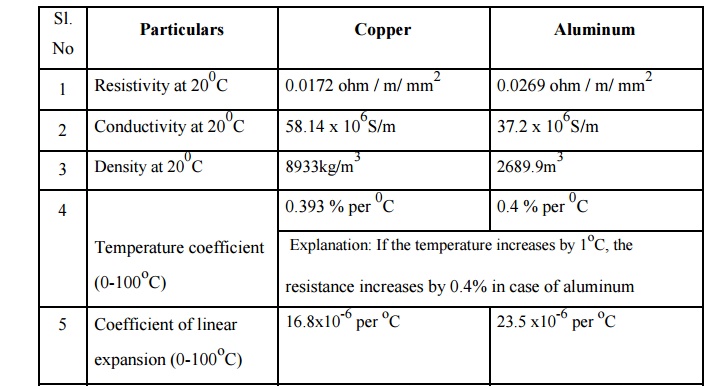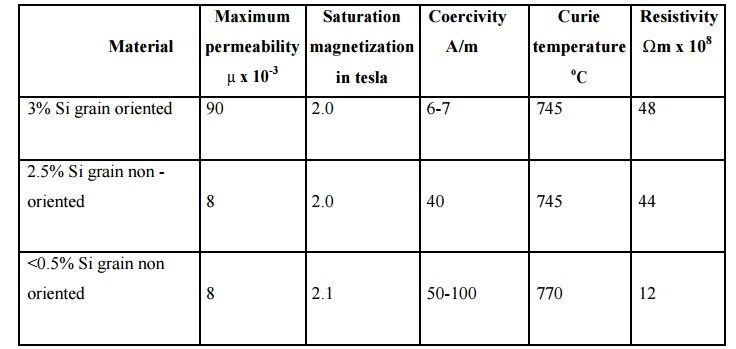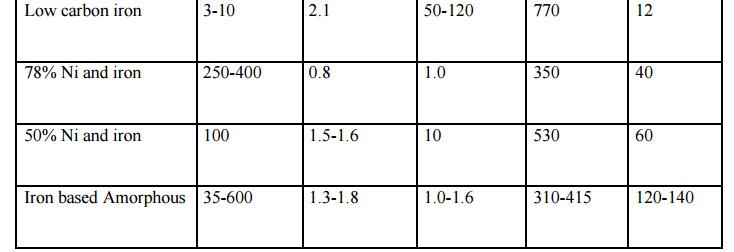Chapter: Design of Electrical Machines : Introduction
Materials for Electrical Machines
Materials for Electrical Machines
The main material characteristics of relevance to electrical machines are those associated with conductors for electric circuit, the insulation system necessary to isolate the circuits, and with the specialized steels and permanent magnets used for the magnetic circuit.
Conducting materials
Commonly used conducting materials are copper and aluminum. Some of the desirable properties a good conductor should possess are listed below.
a) Low value of resistivity or high conductivity
b) Low value of temperature coefficient of resistance
c) High tensile strength
d) High melting point
e) High resistance to corrosion
f) Allow brazing, soldering or welding so that the joints are reliable
g) Highly malleable and ductile
h) Durable and cheap by cost
Some of the properties of copper and aluminum are shown in the table


For the same resistance and length, cross-sectional area of aluminum is 61% larger than that of the copper conductor and almost 50% lighter than copper. Though the aluminum reduces the cost of small capacity transformers, it increases the size and cost of large capacity transformers. Aluminum is being much used now a day’s only because copper is expensive and not easily available. Aluminum is almost 50% cheaper than Copper and not much superior to copper.
Magnetic materials: The magnetic properties of a magnetic material depend on the orientation of the crystals of the material and decide the size of the machine or equipment for a given rating, excitation required, efficiency of operation etc.
1. The some of the properties that a good magnetic material should possess are listed below. 1. Low reluctance or should be highly permeable or should have a high value of relative permeability μr.
2. High saturation induction (to minimize weight and volume of iron parts)
3. High electrical resistivity so that the eddy EMF and the hence eddy current loss is less
4. Narrow hysteresis loop or low Coercivity so that hysteresis loss is less and efficiency of operation is high
5. A high curie point. (Above Curie point or temperature the material loses the magnetic property or becomes paramagnetic, that is effectively non-magnetic)
6. Should have a high value of energy product (expressed in joules / m3).
Magnetic materials can broadly be classified as Diamagnetic, Paramagnetic, Ferromagnetic, Antiferromagnetic and Ferrimagnetic materials. Only ferromagnetic materials have properties that are well suitable for electrical machines. Ferromagnetic properties are confined almost entirely to iron, nickel and cobalt and their alloys. The only exceptions are some alloys of manganese and some of the rare earth elements.
The relative permeability μr of ferromagnetic material is far greater than 1.0. When ferromagnetic materials are subjected to the magnetic field, the dipoles align themselves in the direction of the applied field and get strongly magnetized.
Further the Ferromagnetic materials can be classified as Hard or Permanent Magnetic materials and Soft Magnetic materials.
a) Hard or permanent magnetic materials have large size hysteresis loop (obviously hysteresis loss is more) and gradually rising magnetization curve.
Ex: carbon steel, tungsten steal, cobalt steel, alnico, hard ferrite etc.
b) Soft magnetic materials have small size hysteresis loop and a steep magnetization curve.
Ex: i) cast iron, cast steel, rolled steel, forged steel etc., (in the solid form).
Generally used for yokes poles of dc machines, rotors of turbo alternator etc., where steady or dc flux is involved.
ii) Silicon steel (Iron + 0.3 to 4.5% silicon) in the laminated form. Addition of silicon in proper percentage eliminates ageing & reduce core loss. Low silicon content steel or dynamo grade steel is used in rotating electrical machines and are operated at high flux density. High content silicon steel (4 to 5% silicon) or transformer grade steel (or high resistance steel) is used in transformers. Further sheet steel may be hot or cold rolled. Cold rolled grain oriented steel (CRGOS) is costlier and superior to hot rolled. CRGO steel is generally used in transformers.
c) Special purpose Alloys:
Nickel iron alloys have high permeability and addition of molybdenum or chromium leads to improved magnetic material. Nickel with iron in different proportion leads to
i. High nickel permalloy (iron +molybdenum +copper or chromium), used in current transformers, magnetic amplifiers etc.,
ii. Low nickel Permalloy (iron +silicon +chromium or manganese), used in transformers, induction coils, chokes etc.
iii. Perminvor (iron +nickel +cobalt)
iv. Pemendur (iron +cobalt +vanadium), used for microphones, oscilloscopes, etc. (v) Mumetal (Copper + iron)
d) Amorphous alloys (often called metallic glasses):
Amorphous alloys are produced by rapid solidification of the alloy at cooling rates of about a million degrees centigrade per second. The alloys solidify with a glass-like atomic structure which is non-crystalline frozen liquid. The rapid cooling is achieved by causing the molten alloy to flow through an orifice onto a rapidly rotating water cooled drum. This can produce sheets as thin as 10μm and a meter or more wide.
These alloys can be classified as iron rich based group and cobalt based group.


Insulating materials.
To avoid any electrical activity between parts at different potentials, insulation is used. An
ideal insulating material should possess the following properties.
1) Should have high dielectric strength.
2) Should with stand high temperature.
3) Should have good thermal conductivity
4) Should not undergo thermal oxidation
5) Should not deteriorate due to higher temperature and repeated heat cycle
6) Should have high value of resistivity ( like 1018 Ωcm)
7) Should not consume any power or should have a low dielectric loss angle δ
8) Should withstand stresses due to centrifugal forces ( as in rotating machines), electro dynamic or mechanical forces ( as in transformers)
9) Should withstand vibration, abrasion, bending
10) Should not absorb moisture
11) Should be flexible and cheap
12) Liquid insulators should not evaporate or volatilize
Insulating materials can be classified as Solid, Liquid and Gas, and vacuum. The term insulting material is sometimes used in a broader sense to designate also insulating liquids, gas and vacuum.
Solid: Used with field, armature, and transformer windings etc. The examples are:
1) Fibrous or inorganic animal or plant origin, natural or synthetic paper, wood, card board, cotton, jute, silk etc.,
2) Plastic or resins. Natural resins-lac, amber, shellac etc., Synthetic resins-phenol formaldehyde, melamine, polyesters, epoxy, silicon resins, bakelite, Teflon, PVC etc
3) Rubber : natural rubber, synthetic rubber-butadiene, silicone rubber, hypalon, etc.,
4) Mineral : mica, marble, slate, talc chloride etc.,
5) Ceramic : porcelain, steatite, alumina etc.,
6) Glass : soda lime glass, silica glass, lead glass, borosilicate glass
7) Non-resinous : mineral waxes, asphalt, bitumen, chlorinated naphthalene, enamel etc.,
Liquid: Used in transformers, circuit breakers, reactors, rheostats, cables, capacitors etc., & for impregnation. The examples are:
1) Mineral oil (petroleum by product)
2) Synthetic oil askarels, pyranols etc.,
3) Varnish, French polish, lacquer epoxy resin etc.,
Gaseous: The examples are:
1) Air used in switches, air condensers, transmission and distribution lines etc.,
2) Nitrogen use in capacitors, HV gas pressure cables etc.,
3) Hydrogen though not used as a dielectric, generally used as a coolant
4) Inert gases neon, argon, mercury and sodium vapors generally used for neon sign lamps.
5) Halogens like fluorine, used under high pressure in cables
No insulating material in practice satisfies all the desirable properties. Therefore a material which satisfies most of the desirable properties must be selected.
Related Topics